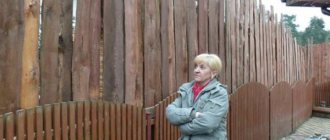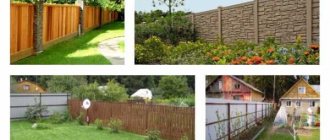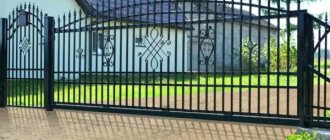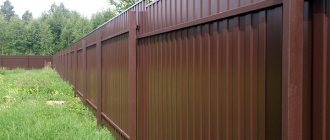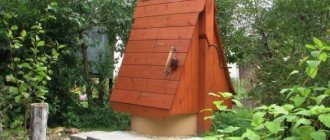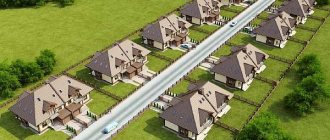The height of the fence is a standard clearly defined in SNiP 30-02-97*. Its new edition was adopted in 2021. This is SP 53.13330.2019. Compliance with the standards is mandatory in individual housing construction plots according to the law for 2020-2021, and in other types of land ownership - summer cottages, SNT, private household plots and in populated areas. But there are nuances that determine how high the fence between neighbors should be, as well as the material it is made of, and the existence of a mutual notarized agreement. They allow you to install a fence with deviations from accepted rules.
In a private house
Basic documentation
Note that restrictions on the height of the fence on the street side were not officially adopted. This should not be forgotten. The maximum permissible height is determined by municipal or local authorities, but for the façade of a private house, according to the law of the Russian Federation, no specific parameter is provided. A very high fence can be installed from the street even in SNT, when neighbors and the management of the non-profit association have no complaints about this.
Fence between neighbors in a village
Basic requirements for a fence on the site:
- According to the current law, land allotment must be limited to the extent confirmed by ownership documents from an authorized cadastral institution with a state license. And even at the dacha, according to the law, the boundaries of the site are marked by a fence.
- Federal standards established in SNiP apply only to the standard that determines how high a fence can be installed between neighbors. The need to designate the optimal parameter arose to prevent numerous disagreements and disputes. By observing this parameter, you can prevent violation of the rights of owners on either side of the fence.
- According to GOST, it should not contain damaging elements that could cause damage to passers-by, children, neighbors, or the family of the owner of the plot.
- Officially determined, the height of the fence between neighboring plots by law should not exceed the required level in order to prevent darkening of the garden, lack of aeration and other unpleasant aspects that may result in complaints and demands or height restrictions.
- A fence higher than SNiP (SP) norms is acceptable if the fence has the necessary transparency for light and air, but at the same time achieves its intended purpose - it closes the area from prying eyes. It does not matter whether the fence is built of brick or wood. Using both materials, it is possible to build in such a way that the requirement of permeability is maintained, and the neighboring plot does not suffer.
High fence in the city
The SNiP collection, adopted since 2010 as a legislative argument in legal disputes, or the GOST, compiled long ago, which has not lost any relevance - all these are methodological guidelines for determining the maximum height of a fence in accordance with the standards.
To correctly determine the maximum permissible parameters of the front part of the fence, it is better to consult with a competent lawyer who deals with such issues. He is also aware of the restrictive regulations existing by the regional authorities.
In order to install a fence between areas, you need to refer to SP 30-102-99 or rely on SP 53.13330.2019.
But the latter, even with adjustments, is not responsible for what the fence between neighbors should be according to the law in 2020-2021, where the vertical size is determined only on dacha plots.
In Moscow, St. Petersburg or any other city, you will need the Town Planning Code or instructions from city authorities; the height of the fence between neighbors in a private house depends on the instructions of local or regional norms and requirements. In SNT, this issue may be determined by the charter of the gardening partnership.
Read: Safe distance from power lines to the fence: the norm according to SNiP and the law in the areas of SNT and individual housing construction
Need to pay attention
Earlier, in 2021, amendments to SP 53.13330.2011 were adopted, according to which the height of the fence in a dacha cooperative between neighboring private houses and plots cannot exceed 1.5 meters, and the material can only be chain-link mesh.
Country houses
But no one prohibits construction at a dacha with other parameters if a written agreement is reached with the neighbor and the administration is notified about this. In 2021, this situation remains the same and no new standards have been adopted.
Law enforcement by neighbors
What height the fence should be is determined by the current legislation of the Russian Federation for SNT, individual housing construction, ONT, private household plots, DNP. In case of non-compliance with the pre-established standards, the owner may be required to demolish the fence through a judicial procedure. However, the majority believes that determining the height of a fence can be done purely individually, and do not want to listen to common sense. In this case, neighbors can act according to the law and report violations to the appropriate authorities.
Some people want to protect their property from prying eyes, and they do not agree to comply with fence height regulations. In this case, it is better to try to resolve the conflict on your own and talk to your neighbors in person. Perhaps they will agree to deviate from generally accepted rules or will even be interested in such actions.
Standards for fence
The legislation on development in 2011 was supplemented by a decree according to which even the maximum height of 150 cm (the generally accepted norm) is not considered legal if the rule of opacity to air or light is violated. It also applies to individual housing construction (private sector), but deviations may again be allowed if the other party to the agreement has no objections and is ready to confirm its consent in writing.
At the same time, the front fence does not have such restrictions; its maximum height is not limited in order to protect the household from attacks by intruders from a city street or driveway in the village.
But it is necessary to take into account that:
- GOST has long determined the requirements for a fence according to the material of manufacture (brick or corrugated board), safety precautions when working at height, as well as taking precautions when working with different types of building materials;
- the main purpose determines the placement of part of the fence - on the facade, between plots, on the back side or along the road, the location of the house on the edge of a populated area;
- 5 meters is the most optimal parameter for a perimeter fence - it allows you to jump over and climb over in case of emergency, but protects access to your neighbor’s land under normal conditions;
- one of the main points is the territorial affiliation of the land plot (the charters of partnerships or dacha cooperatives may allow deviations from the norms);
- the height may be prohibited or permitted on the basis of sanitary and hygienic, fire safety rules or public safety standards.
Permissible fence height according to the law and SNiP standards in 2021
As a rule, the installation of a fence can be determined by the terrain (non-standard slope, windy side, requiring additional protective measures during installation) or the characteristics of the climatic zone. This is especially true for the now popular profiled sheet, which can give a sailing effect and create an additional threat of destruction (and therefore a danger to others).
We must not forget that federal laws do not establish the maximum permissible height of a street fence, provided that safety regulations are followed. The only thing that needs to be observed in an individual structure is the distance from the gate or gate to the roadway of at least 2 meters 50 centimeters. Otherwise, you need to build in such a way that the opening occurs inward, onto the local area.
Sample
The agreement must include the following information:
- details of the parties (full name, passport details, registration address);
- information about rights to a land plot (details of the title document and extracts from the Unified State Register of Real Estate);
- address and area of the site;
- cadastral numbers of plots;
- description of the fence (height, density, location);
- cost of making a fence;
- procedure for distribution of expenses;
- data on the consent of the parties to the installation;
- signatures of the parties.
Sample agreement between neighbors to install a fence
Requirements of the law and norms of SNiP (SP)
Most citizens of the Russian Federation either own individual land plots of various forms of ownership, or save money to acquire them. According to today's legislation, every owner must build a fence to mark the boundaries of his land. Therefore, it is necessary to install street barriers.
Indentations from the fence on the individual housing construction site according to the law in 2020-2021
The main document for compliance with fence construction standards is considered to be SP 53.13330.2011 (SNiP 30-02-97 as amended), to which some adjustments were made in 2021.
Therefore, now you need to be guided by an even newer edition, which determines what the maximum height of the fence at the boundary between neighboring plots should be according to the law.
Although neither the old nor the new edition of the joint venture indicates how many meters will be considered legal when constructing the front part of the fence or the back part, facing another street or driveway, if the site is located end-to-end.
Long-term construction practice indicates that the absence of restrictions at the federal level does not mean that there are no defining documents at the territorial level. Meanwhile, failure to comply with current standards risks administrative liability or even criminal liability, depending on what law was violated by the owner.
Read: Distance from garbage containers to a residential building: SNiP, SanPiN standards from garbage cans
Wooden fence on a private plot
We must not forget that the Law of the Russian Federation in 2021 regulates the parameters of the fence only in some cases. These include:
- personal subsidiary plots (PHS), where it is allowed to grow crops and breed birds and livestock;
- gardening non-profit partnerships (SNT), which may have additional requirements for the appearance and height of fences facing the street;
- dacha partnerships that do not have a commercial background (so-called dacha cooperatives).
Who should pay and be responsible for the fence?
The decision of who will bear the costs and be considered responsible for the safety of the fence depends on the specific location of the fence:
- a beautiful fence along the border of the plot belongs to the person on whose side of the plot the building is located;
- the owner of the area where the fence is located is responsible for the condition of the fence;
- when a fence is erected exactly along the border of the plots, all measures regarding the adjacent fence must be coordinated by the parties.
Read: The height of the fence between neighbors according to the law 2020-2021: in a private house of individual housing construction and on a plot in SNT
Some features
It is unlikely that anyone wants to incur additional costs in connection with the fence. As a rule, the costs are borne by those who are interested in separation and have financial resources. It is always difficult to achieve the consent of neighbors, so land owners are left with 2 options:
- erect a structure exclusively on the territory of one’s own plot and independently;
- abandon the fence altogether.
If the fence is deliberately destroyed, it is necessary to call the police and record the fact of damage to someone else's property. The violator must repair the structure or rebuild it.
When erecting a fence, take into account that the standards established by SNiP are advisory. To avoid problems, it is better to additionally contact the local administration.
Placement of buildings at the dacha
Lawyers advise initially discussing the details of fence construction with neighbors and recording them in writing. In this case, the owner protects himself from attacks on the dismantling of the structure, the construction of which was agreed upon.
Features of legislation
However, even according to the federal laws of the Russian Federation in 2021, there are no height restrictions for the construction of a street fence. To build a high barrier against intruders, you will not need permission to build a part overlooking a quarry or ravine. By the way, the law does not prohibit leaving hard-to-reach areas without a fence, from which access to the site is difficult due to the terrain.
Fence between neighbors in the country
The basic requirements for the construction of a barrier from the street, described in the standards, are conditional in nature - not to pose a threat to others and not to interfere with ventilation and lighting.
But since there are no standards for ventilation and illumination of public areas (at least not yet), it is very difficult to prove in a lawsuit that excessive height interferes with anything.
One way or another, in the private sector, when building a townhouse or cottage in an urban environment, restrictions adopted by city authorities or the Town Planning Code may become an obstacle.
It should be noted that the standard level of street fences is a common occurrence in an urban village or in an SNT (garden partnership). But if, after consulting with a lawyer, it turns out that the individual housing construction is located in a rural area where there are no regulations, the height requirements will be determined by other factors.
First of all, there must be a strip foundation for the fence, if a euro-picket fence or corrugated sheet is used (this also applies to heavy metal fences), the fire safety of the building, and the strength of the pillars used in the installation of the fence.
The photo below shows the fence of a private house in the village.
Fence between neighbors on a private housing plot
As a rule, experts advise limiting the height to no more than 2.2–2.5 meters. It is optimal if the owner of the land needs to limit access to any type of local area, prevent entry into it through a fence, or limit access to the garden with fruits.
In the latter case, it must be taken into account that the distance to a high tree from the fence should be at least 4 meters. And even if there are no restrictions, it is better to focus on the height of the neighbors’ fence. Otherwise, neighbors will be able to file more than one lawsuit.
Blind fencing and requirements for them
Example of a blind fence
A fence with an indicator of 5 meters or more can be erected simultaneously for several reasons, but often in order to:
- provide the required level of noise insulation (settlements are often located along highways and roads, and the first houses (townhouses with balconies) are fenced with a fence of 5 meters or less);
- ensure complete isolation between neighbors' houses.
Watch a video about the permissible height of fencing in the Moscow region according to the 2022 law.
However, it is still recommended to pay attention to the following recommendations:
- Between sections, the height of the fence should not exceed 1.5 meters. Everything above is only subject to written agreement with the neighbors.
- Blind hedges should not exceed 2.2 meters in size.
- This type of fence can be installed exclusively on the side of the roadway and the main facade of a residential building.
The following materials are often used for the construction of fences:
- slate;
- corrugated sheeting;
- brick;
- concrete;
- sheet material.
Corrugated fencing
How to build a fence between plots
Let us immediately emphasize that the new federal law on fences provides additional conditions for delimiting small areas. In the previous edition, it was still possible to build a fence that was permeable to air and light, while avoiding any complaints.
Standards for the location of buildings on sites in SNT and individual housing construction according to SNiP (SP) and SanPiN in 2020-2021
Today, in the law discussed by legislators since 2021, there are no discrepancies in the understanding of height - one and a half meters, or even better - a meter, and the structure must certainly be mesh. Fencing cannot be installed higher without proper approvals.
This is caused not only by the need to comply with housing standards in very limited areas, but also by fire requirements and rules. The main method recommended in such cases is to reach a mutual agreement with a neighbor. All this applies to the Moscow and Leningrad regions (MO and LO), Moscow, St. Petersburg and all other regions of Russia, be it cities, villages or rural settlements.
Read: Distance from the barbecue to the residential building and neighbors’ fence: SNiP fire safety standards
But if the relationship doesn’t work out, you shouldn’t despair; there are several other methods for creating a solid fence:
- you can install a mesh structure of the required height and make it impenetrable to prying eyes (the Internet is replete with similar methods - from embroidery with old threads to camouflage mesh and threading plastic slats);
- note that, moving away from the demarcation boundary exactly one meter (but not a centimeter less), you can build a fence of any configuration and degree of impenetrability (the ban on a solid fence only applies to one that runs exactly along the demarcation boundary, but on your own site you can do the same) ;
- establish at least one hive on the site - bees are subject to the apiary law, and this makes it possible to build a structure of the required height;
- resort to constructing a low solid fence, and build up the rest of the part with transparent material that transmits light and reflects prying eyes (such materials are already on sale, but this is not a cheap pleasure).
Moreover, the last technique has been tested several times, and there is documentary evidence of this. Low, meter high, installed on the boundary, this is a signal one. With its help, you can insure yourself against bad neighbors if they decide to seize what they think is free territory.
Below is a video on this topic.
What is the maximum height used in practice?
In addition to the fact that the fence serves as a fence, it also has some decorative functions. If you make a fence too high, the owner will be the first to suffer. Fences that are too high do not allow the sun's rays to penetrate into the territory of the cottages, making it dark and faceless. If the plot is ten acres or more, then the construction of barriers two meters high on the side of the roadway is allowed.
Also, the existing Law on Beekeeping states that if there is an apiary, hives and bees on the site, then this allows you to erect a continuous fence between neighbors 2 meters high. In 2021, 2021 and 2022, many owners in rural areas are successfully using this.
The fence made of forged metal and polycarbonate is made taking into account all standards
The following rule should be followed: the higher the fence you plan to make, the more transparent the material should be used.
In remote areas, you should take care of ventilation yourself (holes at the level of fifteen centimeters from the ground level). If this is not done, then the constant dampness will not go away, after which mustiness and mold will appear everywhere. If the owner has 20 acres, then it is allowed to erect a fence 3.5 meters high in agreement with the local administration.
What else to pay attention to
Note that if you keep all payment documents from the company that will supply building materials and take photographs of the second blind fence, which is everywhere at least a meter apart, the court upholds its construction. Disputes may arise over the fact that the fence damages the plantings in the neighbor's garden. In this case, you can demand an examination - it is not cheap, and the neighbors will pay for it - the losing party is guaranteed.
Often, the need to build a blind fence arises from constant grassing of plantings by neighbor's livestock, walks by a dog that has chosen someone else's garden as a hunting ground. If pets are large, then it will not be difficult for them to jump over a low fence. True, cats can also penetrate through the roof, where they get through the balcony, but this is no longer so dangerous for crops.
The photo shows a high neighbor's hedge.
Fencing between plots in a private house
Temporary fences and rules for their installation
During the construction process, teams of workers often erect temporary fences. Often we are talking about erecting a fence made of picket fence, chain-link mesh, or a wooden fence, but not a brick one. There is no need to build a foundation. However, to ensure the safety of residents of neighboring areas, a fence must be erected during reconstruction and construction work.
The photo shows the new construction site fence on the street in 2022.
Temporary fencing
If for some reason it is necessary to install something higher and more serious than a wooden fence, then after going through the procedure in accordance with the procedure established by law, you can install a more substantial fence, whose height can reach 3 meters or more (5 meters). The height of the corrugated fence in this case will be 3 meters or more.
Based on the current SNiP 3.01.01-85, all construction work is conditionally divided into three stages:
- Carrying out preliminary work to prepare the site allocated for construction or reconstruction. It is allowed to apply markings, construct a pit, prepare a site for a foundation, level the territory and dismantle unnecessary structures. Before leveling the area around the perimeter and installing a standard fence, you should obtain the appropriate permission.
- Reconstruction or construction of a residential building made of brick - in accordance with the current state standard (hereinafter referred to as GOST).
- After this, you can begin installing the fence at the dacha. It is possible to use corrugated sheets for a fence, fencing a summer cottage and installing gates (sometimes a gate is installed). Gates can be installed both at the beginning and at the end of the fence construction process.
Shoe guard is easy to install
But temporary fencing includes:
- Mobile structures. In this case, it is allowed to install fences with strong supporting structures, the height of which can reach 3 meters or more. It is on them that the entire load of the structure will be placed, including the weight of the gate. To improve durability, poles and gates are treated with primers and paints.
- Stationary fencing. Height may vary. Installation is acceptable in places where reconstruction or long-term construction is planned. Most often, preference is given to installing sectional fencing rather than a wooden fence. They are easy to dismantle and quite durable. Their height can reach three meters. They can be installed within a day and dismantled in an even shorter period of time. As a covering, a chain-link mesh and a galvanized profile are often used, from the remains of which gates are made. Coating with anti-corrosion compounds is encouraged.
When a neighbor violates the rules
It must be emphasized that the height of the fence between neighboring areas must be observed by law. The courts are considering a huge number of precedents with violations, especially if the person on the other side of the fence has recently moved and completely ignores the requirements of the rules. As a result, the question arises: what to do in case of violations by a neighbor?
High fence between neighbors on individual housing construction land
Therefore, the new version of the law seemed to be a necessary measure back in 2018, although it only came into force in January 2021. Please note that today the new law remains relevant.
Judicial practice shows that when considering a claim in court, it is now possible to refer not only to existing regulations, but also to a new edition that has legal force.
Although for several years now, the court has been taking into account the standards and requirements of SNiP and SP, SanPiN and fire safety.
Capital fence on a summer cottage in SNT
The main goal that all regulatory documentation sets for itself is to ensure the safety of people, prevent access by strangers, as well as intruders and animals, guaranteed respect for the rights of the owner, which is ensured by Article 304 of the Civil Code of the Russian Federation. Under this article, the owner may demand restoration of his legal rights, confirmed by documents of ownership.
Legal questions about the definition of a fence and its construction
Often, landowners do not agree with the fact that they must pay for the fence solely at their own expense. However, the law does not require the owner of the plot to participate in the construction of such structures or pay half of the costs. Everyone decides the issue individually - to install a fence at their own expense or to postpone the solution of the issue until the time when the owner of the land on the other side does not agree to spend the money.
It is not always possible to avoid litigation if pets or birds bred on a neighbor’s property damage the fence.
There is no single established judicial practice in such claims and litigants will need a good knowledge of the laws and judicial procedure.
Facade fence
Here it is advisable to contact a lawyer and get additional advice on how to behave correctly in the event of a violation of your rights, as well as what to do to protect yourself.
✅ How to write?
Before you begin drawing up a conciliation document, you should consider the following recommendations for its preparation:
- It must be in writing (printed or handwritten) and cannot be considered provided only from the words of neighbors.
- It is provided only by owners of neighboring plots whose interests may be affected by the construction of a fence. It cannot be issued on behalf of their family members, tenants or persons occupying the territory on other grounds.
- Accurate information about the construction initiator, his neighbors, and the land plots themselves is indicated, which will allow them to be easily identified if necessary.
- The date corresponding directly to the date of preparation or signing is indicated.
- It is secured by the personal signatures of all persons indicated in the document.
To give the document greater legal weight, it is recommended to have the signatures certified by a notary. In this case, the neighbor will have no reason to retract his words (for example, to claim a forged signature or come up with other excuses).
